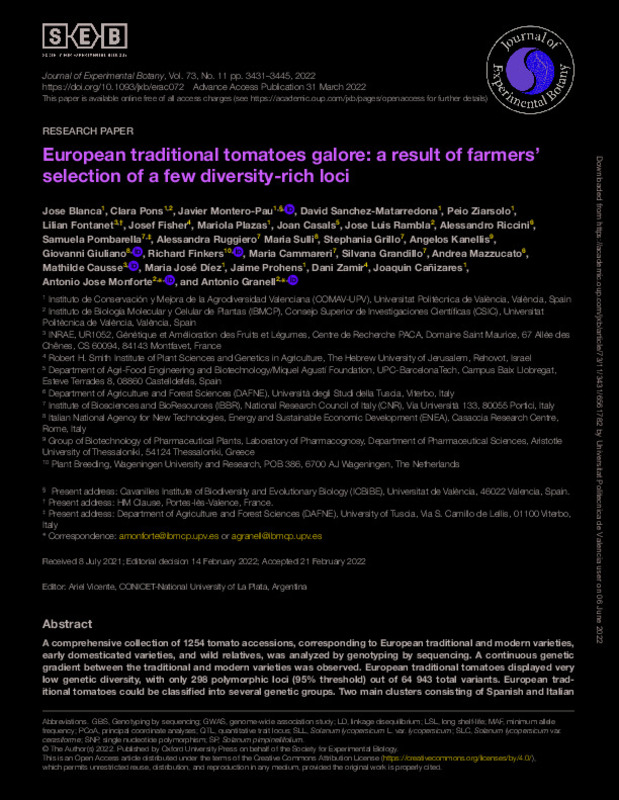JavaScript is disabled for your browser. Some features of this site may not work without it.
Buscar en RiuNet
Listar
Mi cuenta
Estadísticas
Ayuda RiuNet
Admin. UPV
European traditional tomatoes galore: a result of farmers' selection of a few diversity-rich loci
Mostrar el registro sencillo del ítem
Ficheros en el ítem
| dc.contributor.author | Blanca Postigo, José Miguel
|
es_ES |
| dc.contributor.author | Pons Puig, Clara
|
es_ES |
| dc.contributor.author | Montero-Pau, Javier
|
es_ES |
| dc.contributor.author | Sánchez-Matarredona, David
|
es_ES |
| dc.contributor.author | Ziarsolo, Peio
|
es_ES |
| dc.contributor.author | Fontanet, Lilian
|
es_ES |
| dc.contributor.author | Fisher, Josef
|
es_ES |
| dc.contributor.author | Plazas Ávila, María de la O
|
es_ES |
| dc.contributor.author | Casals, Joan
|
es_ES |
| dc.contributor.author | Rambla Nebot, Jose Luis
|
es_ES |
| dc.contributor.author | Riccini, Alessandro
|
es_ES |
| dc.contributor.author | Pombarella, Samuela
|
es_ES |
| dc.contributor.author | Ruggiero, Alessandra
|
es_ES |
| dc.contributor.author | Suli, Maria
|
es_ES |
| dc.contributor.author | Grillo, Stephania
|
es_ES |
| dc.contributor.author | Díez, Maria José
|
es_ES |
| dc.contributor.author | Prohens Tomás, Jaime
|
es_ES |
| dc.contributor.author | Cañizares Sales, Joaquín
|
es_ES |
| dc.contributor.author | Monforte Gilabert, Antonio José
|
es_ES |
| dc.contributor.author | GRANELL RICHART, ANTONIO
|
es_ES |
| dc.date.accessioned | 2024-04-24T18:06:14Z | |
| dc.date.available | 2024-04-24T18:06:14Z | |
| dc.date.issued | 2022-03-31 | es_ES |
| dc.identifier.issn | 0022-0957 | es_ES |
| dc.identifier.uri | http://hdl.handle.net/10251/203724 | |
| dc.description.abstract | [EN] The high phenotypic diversity observed among European traditional tomato varieties was created by traditional farmer-driven selection by inadvertently combining a very few polymorphic loci subjected to balancing selection. A comprehensive collection of 1254 tomato accessions, corresponding to European traditional and modern varieties, early domesticated varieties, and wild relatives, was analyzed by genotyping by sequencing. A continuous genetic gradient between the traditional and modern varieties was observed. European traditional tomatoes displayed very low genetic diversity, with only 298 polymorphic loci (95% threshold) out of 64 943 total variants. European traditional tomatoes could be classified into several genetic groups. Two main clusters consisting of Spanish and Italian accessions showed higher genetic diversity than the remaining varieties, suggesting that these regions might be independent secondary centers of diversity with a different history. Other varieties seem to be the result of a more recent complex pattern of migrations and hybridizations among the European regions. Several polymorphic loci were associated in a genome-wide association study with fruit morphological traits in the European traditional collection. The corresponding alleles were found to contribute to the distinctive phenotypic characteristic of the genetic varietal groups. The few highly polymorphic loci associated with morphological traits in an otherwise a low-diversity population suggests a history of balancing selection, in which tomato farmers likely maintained the morphological variation by inadvertently applying a high selective pressure within different varietal types. | es_ES |
| dc.description.sponsorship | This work was supported by the European Commission H2020 research and innovation program through TRADITOM grant agreement no. 634561, G2P-SOL, grant agreement no. 677379, and HARNESSTOM grant agreement no. 101000716. MP is grateful to the Spanish Ministerio de Ciencia e Innovacion for a postdoctoral grant (IJC2019-039091-I/AEI/10.13039/501100011033). | es_ES |
| dc.language | Inglés | es_ES |
| dc.publisher | Oxford University Press | es_ES |
| dc.relation.ispartof | Journal of Experimental Botany | es_ES |
| dc.rights | Reconocimiento (by) | es_ES |
| dc.subject | Crop evolution | es_ES |
| dc.subject | Diversification | es_ES |
| dc.subject | Fruit morphology | es_ES |
| dc.subject | Genome-wide association study | es_ES |
| dc.subject | Genotyping by sequencing | es_ES |
| dc.subject | Selection | es_ES |
| dc.subject | Single nucleotide polymorphism | es_ES |
| dc.subject.classification | GENETICA | es_ES |
| dc.title | European traditional tomatoes galore: a result of farmers' selection of a few diversity-rich loci | es_ES |
| dc.type | Artículo | es_ES |
| dc.identifier.doi | 10.1093/jxb/erac072 | es_ES |
| dc.relation.projectID | info:eu-repo/grantAgreement/EC/H2020/101000716/EU | es_ES |
| dc.relation.projectID | info:eu-repo/grantAgreement/EC/H2020/634561/EU | es_ES |
| dc.relation.projectID | info:eu-repo/grantAgreement/EC/H2020/677379/EU | es_ES |
| dc.rights.accessRights | Abierto | es_ES |
| dc.contributor.affiliation | Universitat Politècnica de València. Escuela Técnica Superior de Ingeniería Agronómica y del Medio Natural - Escola Tècnica Superior d'Enginyeria Agronòmica i del Medi Natural | es_ES |
| dc.description.bibliographicCitation | Blanca Postigo, JM.; Pons Puig, C.; Montero-Pau, J.; Sánchez-Matarredona, D.; Ziarsolo, P.; Fontanet, L.; Fisher, J.... (2022). European traditional tomatoes galore: a result of farmers' selection of a few diversity-rich loci. Journal of Experimental Botany. 73(11):3431-3445. https://doi.org/10.1093/jxb/erac072 | es_ES |
| dc.description.accrualMethod | S | es_ES |
| dc.relation.publisherversion | https://doi.org/10.1093/jxb/erac072 | es_ES |
| dc.description.upvformatpinicio | 3431 | es_ES |
| dc.description.upvformatpfin | 3445 | es_ES |
| dc.type.version | info:eu-repo/semantics/publishedVersion | es_ES |
| dc.description.volume | 73 | es_ES |
| dc.description.issue | 11 | es_ES |
| dc.identifier.pmid | 35358313 | es_ES |
| dc.identifier.pmcid | PMC9162183 | es_ES |
| dc.relation.pasarela | S\470436 | es_ES |
| dc.contributor.funder | Instituto de Salud Carlos III | es_ES |
| dc.contributor.funder | COMISION DE LAS COMUNIDADES EUROPEA | es_ES |
| dc.subject.ods | 02.- Poner fin al hambre, conseguir la seguridad alimentaria y una mejor nutrición, y promover la agricultura sostenible | es_ES |








